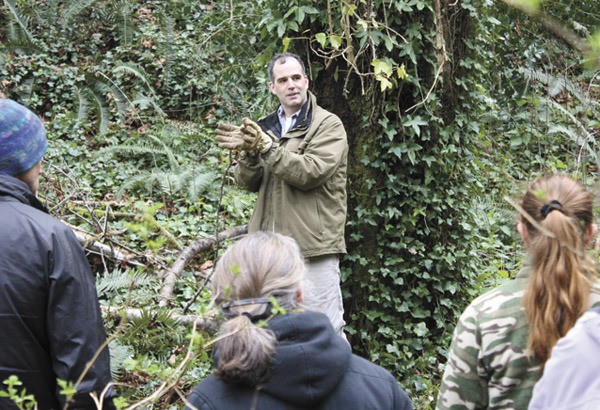In 1995, Greg Rabourn had what Evening Magazine dubbed the worst job in the region.
He was one of four people employed by King County to sort through garbage at its then-three landfills, searching for hazardous material that needed to be pulled out of the trash and disposed of separately. During a summer heat wave, when the work of sorting through piles of garbage in search of paint thinner, solvents and dead animals seemed particularly grim, he and his colleagues won that dubious distinction. John Curly, then the host of the popular television show, actually came on site, cameraman in tow, to profile their work.
But for Rabourn, his stint as a trash-sorter had a silver lining. “That’s how I discovered Vashon,” he said during a recent interview.
Every other week, he’d take a turn at the Vashon landfill, a quiet spot surrounded by forests. And it was then — as a young man with a degree in environmental science and a passion for native ecosystems — that he fell in love with the Island.
Now, Rabourn holds a different distinction: He’s the county’s Vashon-Maury Island Basin Steward, the person who identifies projects the county should undertake to restore habitat and help in the region’s ongoing effort to save imperiled salmon runs.
Four years ago, he deepened his attachment to Vashon, when he and his family moved from Seattle to a three-acre parcel in the woods off of Old Mill Road. His daughter attends McMurray Middle School.
His job these days, he said, is “particularly rewarding, because I feel so connected to the place where I live.”
What’s more, he said, Vashon continues to be a place he loves.
“Vashon’s fantastic,” he said. “It has so many features — from the forests in the Judd Creek area to the salt marshes to the feeder bluffs. There’s so much variety here. It’s really interesting.”
Rabourn, 43, has a bit of name recognition throughout the region. Almost every week, he’s on KUOW, an NPR affiliate, where he joins host Steve Scher and two others to talk about environmentally friendly gardening practices. He’s the one who’s constantly advocating for the use of native plants and wildlife-friendly gardens — a practice he’s trying to employ in his own garden, a small footprint dotted with native Columbia lily, camas, columbine and trillium.
On Vashon, his work has involved a range of projects geared toward habitat restoration that he and others believe will ultimately improve Central Puget Sound’s federally protected salmon runs.
He’s been working to protect a long stretch of shoreline that extends from Dilworth Point south to KVI Beach, a sandy expanse that supports the largest natural-barrier lagoon remaining in Puget Sound. So far, under Rabourn’s direction, the county has purchased several parcels totaling 33.5 acres and 1,500 feet of shoreline; in so doing, Rabourn said, the county is helping to protect the region’s longest drift cell, a naturally occurring system of tidal action and erosion that keeps KVI Beach and the lagoon intact.
He’s working closely with the Vashon-Maury Island Land Trust in its ambitious effort to protect and restore Judd Creek — Vashon’s largest salmon-bearing stream. According to Tom Dean, director of the land trust, Rabourn has played a critical role, bringing both time and money to a project that might otherwise not register in a county focused on much larger river systems and restoration projects.
“Without Greg, I probably wouldn’t get any traction at all there,” Dean said. “He’s been a fantastic partner at Judd Creek.”
Meanwhile, Rabourn’s gearing up on a project that’s particularly far-reaching and compelling to him — he’ll be overseeing the creation of a salt marsh at the beach next to Dockton Park. Funds for the $480,000 project came from a settlement with ConocoPhillips, after a 2004 oil spill in Dalco Passage that fouled hundreds of acres of shoreline.
Salt marshes — once common in the region — have all but disappeared, Rabourn said, and the area in Dockton lends itself perfectly to the recreation of such an ecosystem.
“We just don’t run across pieces of property that have this kind of potential,” he said. “I’m excited about it. I think it’ll be fascinating.”
Rabourn came to love the outdoors as a boy, when he hiked with his grandfather in the woods and foothills outside of Anacortes. Now, he said, he looks around the region with a mixture of both concern and optimism. As Vashon’s basin steward, he knows what success looks like: “Sustaining salmon and orcas in the Puget Sound. That’s the big driver for me,” he said.
But he’s not naive about what it will take. Puget Sound, he said, is experiencing “that death by a thousand cuts.” He and others, meanwhile, are “rebuilding by 1,000 wounds healed — one restoration project at a time.”
“If we do nothing, it’s hopeless,” he said. “But it doesn’t have to be everything at once. Just do something.”



